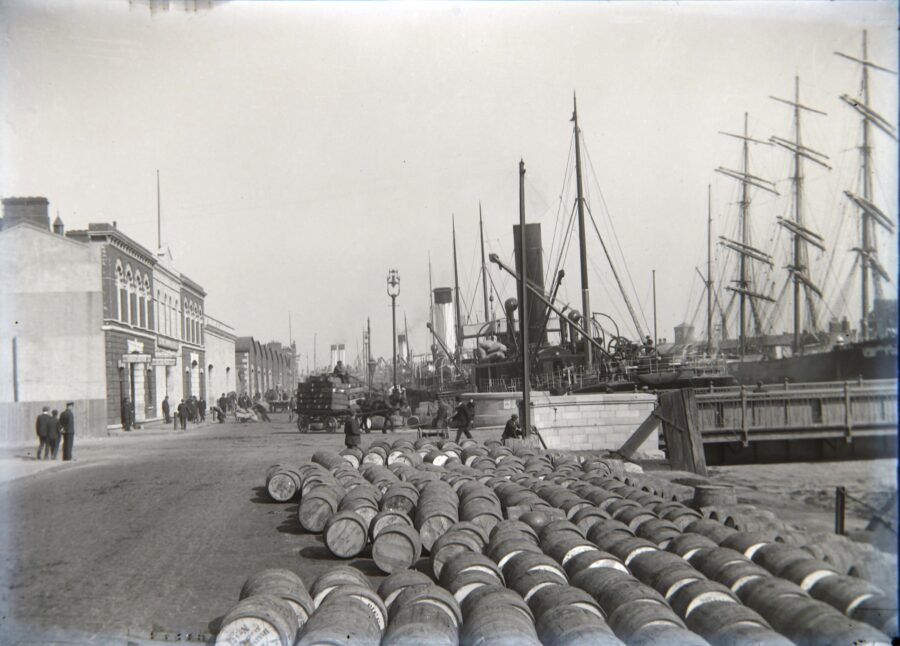
Kieran’s Our City, Our Town Article,
Cork Independent, 6 April 2023
Recasting Cork: A New Customs Regime
At midnight on Saturday 31 March 1923, a new customs regime was inaugurated at all Irish southern ports and approved outlets for ship traffic in the Irish Free State. At the appointed time, customs officers, accompanied by searchers, became active. The officers were attired in blue uniforms, embroidered with gold braiding and with peaked caps to match.
The first vessel to come into Ireland to be examined was the SS Bandon. The ship arrived at Cork’s quaysides before 7am and having berthed, the vessel was at once boarded by customs officers. Luggage, passengers and crew and ships papers were checked. One hour later the SS Olive of the Laird Line, from Heysham, UK, with twenty passengers and cargo arrived. Altogether nine vessels came into Cork’s quaysides on the first day of inspections.
After an interval of 106 years, Irish customs were separated from British customs (into which they were merged in 1817). The Irish Free State assumed full independent control of its fiscal policy – a privilege that had not been enjoyed even under Henry Grattan’s Parliament in the late eighteenth century.
The Irish Free State government under William T Cosgrave took its time to think about a fiscal policy on its own. Many aspects had to be considered so that Ireland could efficiently collect its customs duties. Heretofore customs duties on tea, tobacco, sugar or champagne were collected at London, Bristol and Liverpool. Duties on a small proportion of dutiable goods were also collected at Cork, Waterford and Dublin.
Before April 1923 for British manufacturers the Safe guarding of Industries Act was a key piece of legislation. This measure gave a big preference to British manufacturers as against foreign trade. A tax was applied to Canadian, Australian and South African manufacturers. Ireland lost rather than gained through the operation of that act – for the British manufacturer of articles, which Ireland bought but did not produce had a big preference.
The new customs duties would give Irish manufacturers of goods a certain preference at home. Of course, these goods, if exported, to Great Britain, would have to pay tariffs at the other side. A Cork Examiner editorial on 2 April writes about “loose scare talk” and that thought of economic reprisals should be dismissed; “England is not likely to put a tariff on butter, eggs, beef or bacon; to do so may place the English farmer in a favourite position but the English working man would have to pay the piper. Moreover a British government could not very logically propose reprisals against Ireland for giving trial to a British act of parliament until such time as experience shows how far it ought to be modified… It is highly probable that both the British and Irish governments will find it necessary to alter the existing law. The free trade idea is not dead across the channel, and there are many convinced free traders on this side”.
The following was a list of the principle dutiable articles under the new regulations; tobacco, cigars, cigarettes, spirits, liqueurs, perfumery, beer, coffee, chicory, tea, dried fruit, cocoa, chocolates, sugar and confectionery, molasses and glucose, saccharine, wine, playing cards, musical instruments including gramophones cinematograph films, clocks and watches, gramophone records, wireless, vacuum tubes colour metallic tungsten, compounds of thorium, synthetic organic chemicals, optical instruments, optical glass, scientific glassware, scientific instruments, gauges, matches, table waters on cider, motor cars and accessories, motorcycles, fine chemicals, and laboratory porcelain.
The principle imported articles, which were prohibited were restricted, were extracts of tea, coffee, chicory, and tobacco, foreign reprints of registered copyright works including music come on dogs, arms, ammunition and explosives, prepared opium, cocaine, morphine, diamorphine, heroine and raw and ministerial opium.
In the case of motor cars, every car entering the Irish Free State market that was to be brought via a port or over the boundary of the six counties of Northern Ireland, they would be dutiable to the extent of 33 ½ %. if imported from outside the British Empire, and 22.2% if the place of origin was within the British Empire.
From the date of the announcement of the new customs duties regulations in late February 1923 there was an intense rush on the part of motor dealers to land the greatest possible number of cars in the Irish Free State before the customs duties were enforced. Urgent appeals for immediate delivery were sent from Ireland to British traders. For many days the quays in Irish ports such as Cork and Dublin were congested by abnormal consignments of cars rushed into the country in an attempt to get ahead of the tariffs barrier.
In practical terms, the importing and exporting of merchandise across the Northern Ireland border was banned apart from through select routes and at select times. Construction began on customs huts and stations along the border. Between 9am and 5pm daily, except on Sundays, railway stations were open for the authorisation of merchandise. Farm produce was exempt, as was the exclusion of household furniture and small domestic supplies of non-dutiable goods.
As a result of the Common Travel Area agreed between the British and Irish Free State governments earlier in 1923, there was free movement of people. However, those who crossed the border had their person and personal effects checked to stop smuggling.
Kieran’s April Tours (free, no booking required):
Saturday 15 April 2023, The Friar’s Walk; Discover Red Abbey, Elizabeth Fort, Barrack Street, Callanan’s Tower & Greenmount area; Meet at Red Abbey tower, off Douglas Street, 2pm.
Caption:
1196a. St Patrick’s Quay, Cork, c.1900 by Cork Camera Club (source: Cork Public Museum).